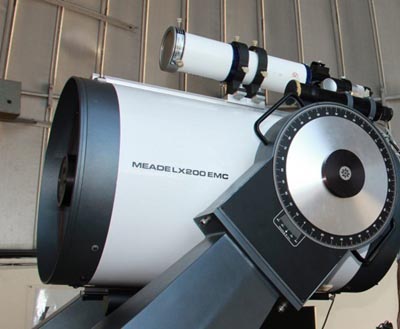
Take in the night sky over the holiday break, and watch as some magical astronomy events unfold in December and into the new year.
Located at York's Keele Campus, the Allan I. Carswell Observatory supports student learning and research and is a hub for public engagement and outreach. It is home to a one-metre telescope – the largest telescope on a university campus in all of Canada – and a 60-centimetre Cassegrain, both equipped with state-of-the-art electronic cameras. As well, the Observatory has five 20-centimetre telescopes available for outdoor viewing during special celestial events.
The Observatory offers a variety of free programming for the public, including public viewing sessions, group tours, our online radio show, online public viewing and more.
Here's what to watch for in December, as suggested by Elaina A. Hyde, director, Allan I. Carswell Observatory.

Dec. 21: The December solstice will take place at 21:48 UTC. Also known as the winter solstice, it is the shortest day of the year in the northern hemisphere. In the southern hemisphere, it is the longest day of the year and is called the summer solstice.
Dec. 21: Mercury will be at its greatest elongation, which makes it a good time to try and spot the planet. Mercury will appear at its farthest distance from the sun in the evening sky.
Dec. 22/23: Ursids meteor shower peaks on Dec. 22 and 23. The Ursids meteor shower is active annually between Dec. 17 and 24. According to Hyde, the shower usually peaks around Dec. 23. At its peak, observers may be able to view as many as 10 meteors in an hour.
Dec. 23: Super new moon. This new moon takes place very close to its perigee – the point on its orbit closest to the Earth.
Events to watch for in the new year
Venus and Saturn conjunction: In January 2023, the brightest planet Venus will become easier to spot as it climbs slightly higher in the twilight sky each evening. Meanwhile, Saturn will start January 2023 high in the twilight sky. But it’ll drop closer to the horizon as January proceeds. And – on Jan. 22, 2023 – Venus and Saturn will appear to brush past each other.
Additionally at York's Keele Campus, the Allan I. Carswell Observatory does online astronomy viewings accessible to the public on Mondays and Wednesdays.

Mondays: The York Universe Radio Show is broadcast on Monday nights (9 to 10 p.m. EST October to March; 9 to 10 p.m. EDT April to September) on the online radio station astronomy.fm. Tune in every week for a new exciting broadcast about what is new in astronomy, this week in history, and amazing interviews with scientists from around the world. Running simultaneously with the York Universe Radio Show is the weekly Online Public Viewing experience on YouTube. Anyone can tune in to see live images from the Obersvatory's four telescopes/cameras when possible, view reduced astronomical images, and chat with Observatory staff, who are happy to answer questions. Requests for objects to observe will be entertained.
Wednesdays: Prior to the pandemic, the Observatory was open for in-person public viewing every Wednesday night. In the absence of weekly in-person public viewings, the Observatory hosts a live TeleTube tour on its YouTube channel every Wednesday night at 7:30 p.m. This online version of public viewing is followed by a Q-and-A session with the Observatory team. In-person public viewing is only available a few days each month. Keep checking the Observatory homepage for dates.
"The next in-person viewing will be at the end of January, so bring your warmest jackets," says Hyde.
Those who want to view old broadcasts or join in live can get the schedule with all the links from the Observatory's new website: https://www.yorku.ca/science/observatory/ or join directly on YouTube at: https://www.youtube.com/user/YorkUObservatory/live.
